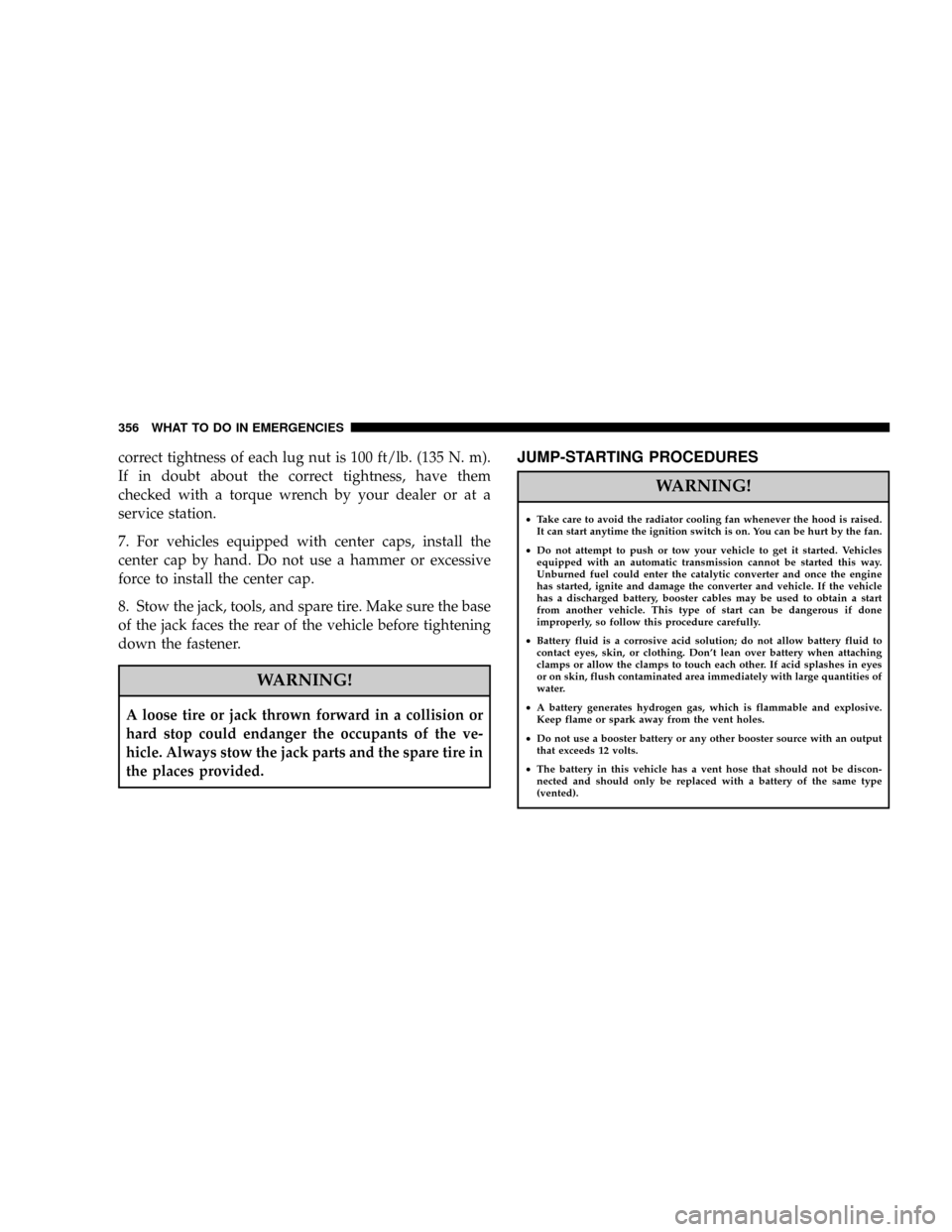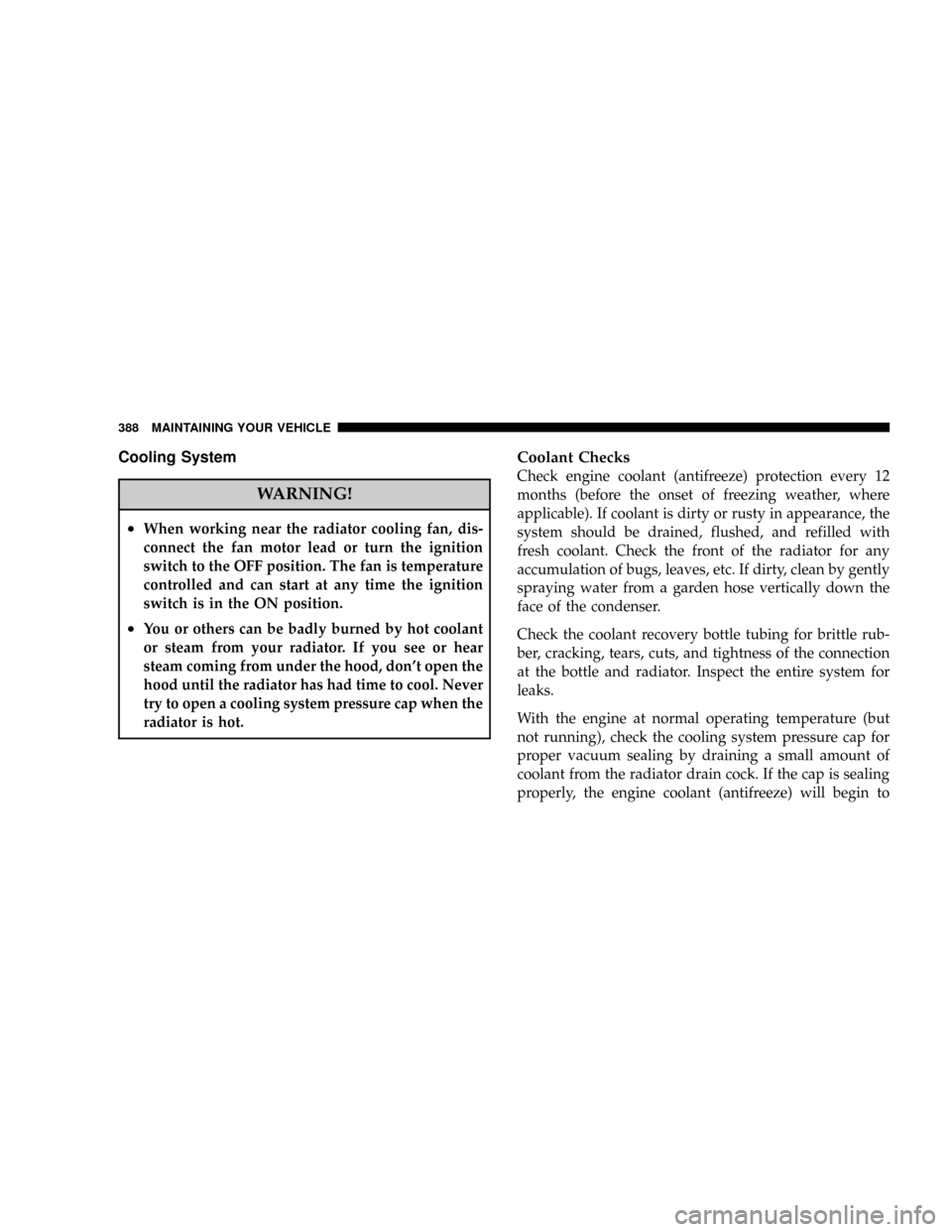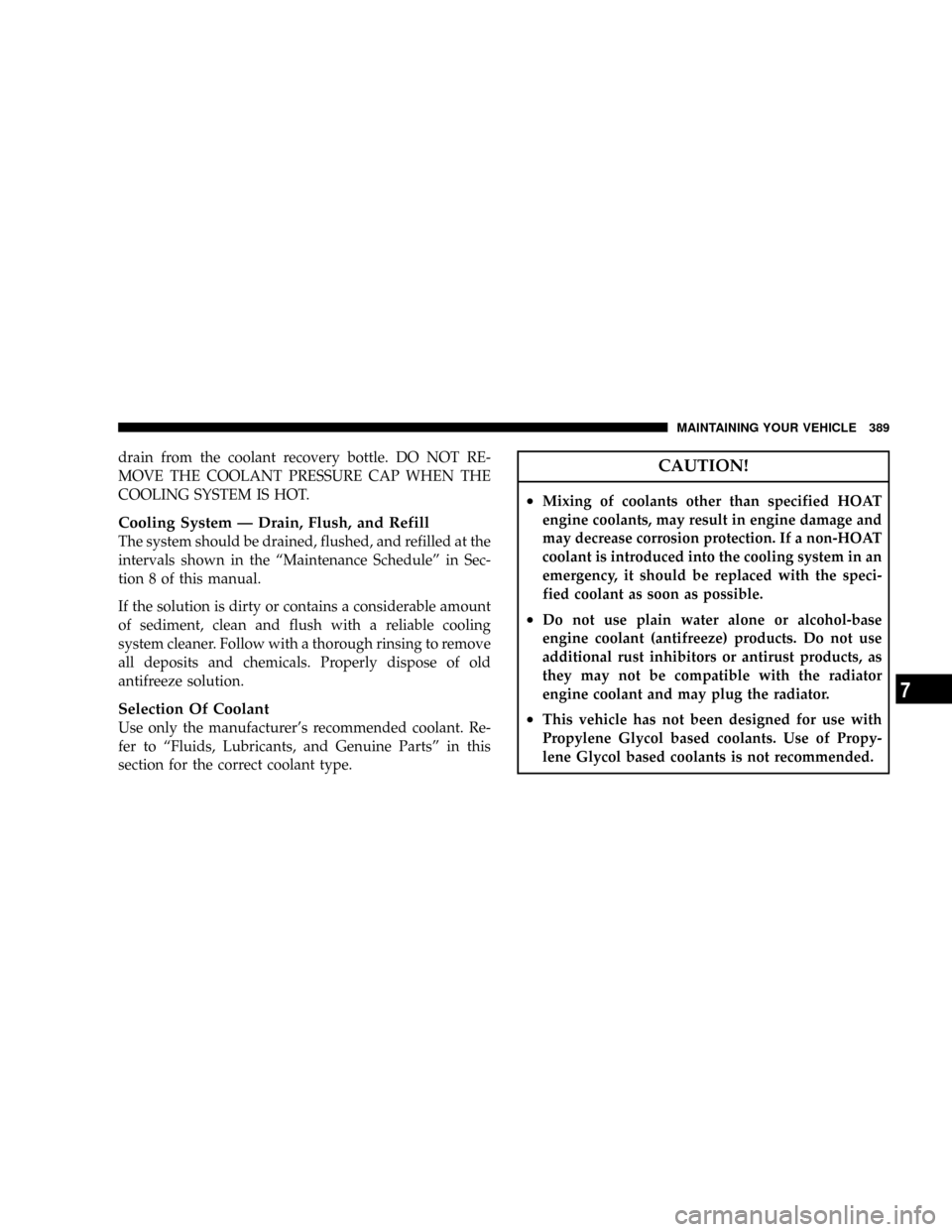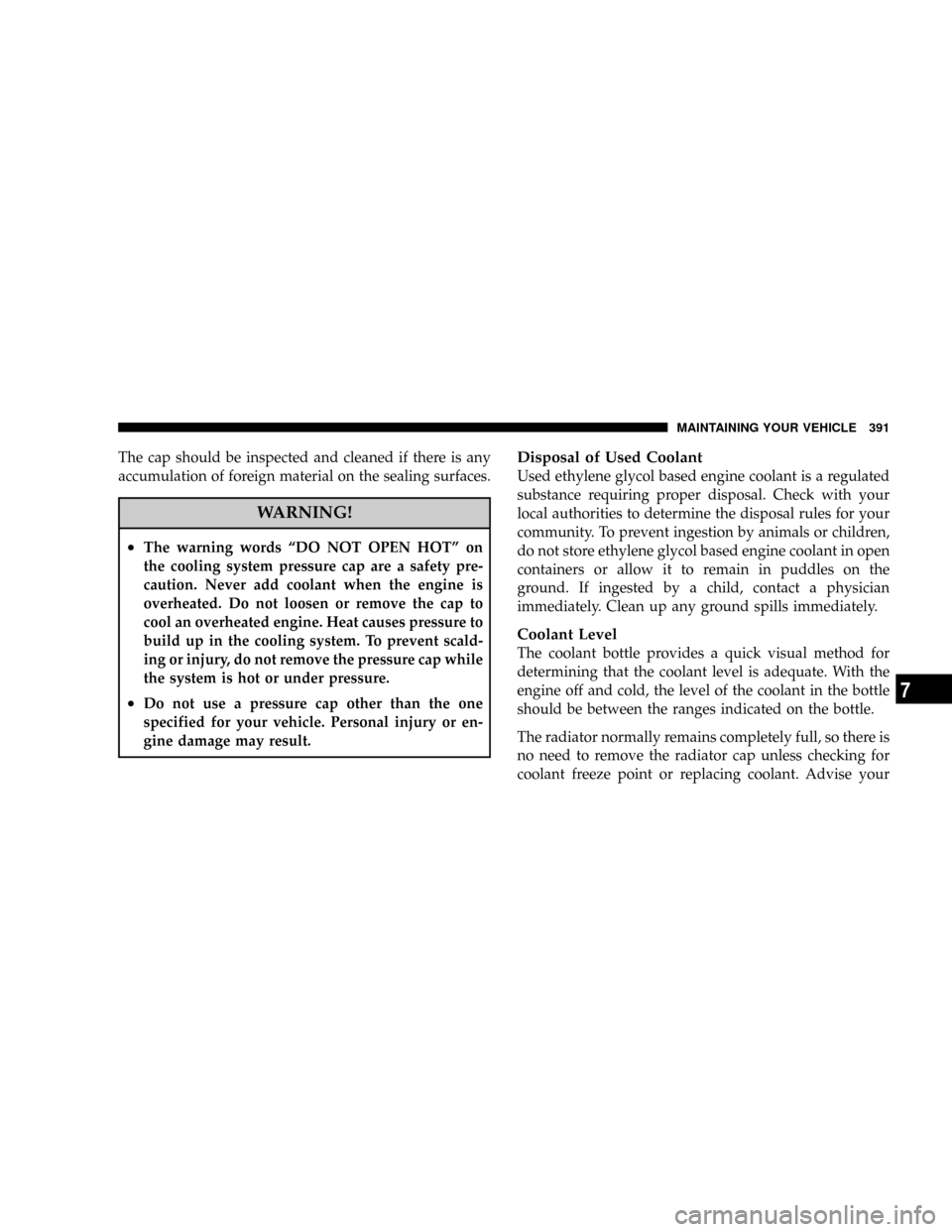2008 DODGE CHARGER radiator cap
[x] Cancel search: radiator capPage 356 of 466

correct tightness of each lug nut is 100 ft/lb. (135 N. m).
If in doubt about the correct tightness, have them
checked with a torque wrench by your dealer or at a
service station.
7. For vehicles equipped with center caps, install the
center cap by hand. Do not use a hammer or excessive
force to install the center cap.
8. Stow the jack, tools, and spare tire. Make sure the base
of the jack faces the rear of the vehicle before tightening
down the fastener.
WARNING!
A loose tire or jack thrown forward in a collision or
hard stop could endanger the occupants of the ve-
hicle. Always stow the jack parts and the spare tire in
the places provided.
JUMP-STARTING PROCEDURES
WARNING!
²Take care to avoid the radiator cooling fan whenever the hood is raised.
It can start anytime the ignition switch is on. You can be hurt by the fan.
²Do not attempt to push or tow your vehicle to get it started. Vehicles
equipped with an automatic transmission cannot be started this way.
Unburned fuel could enter the catalytic converter and once the engine
has started, ignite and damage the converter and vehicle. If the vehicle
has a discharged battery, booster cables may be used to obtain a start
from another vehicle. This type of start can be dangerous if done
improperly, so follow this procedure carefully.
²Battery fluid is a corrosive acid solution; do not allow battery fluid to
contact eyes, skin, or clothing. Don't lean over battery when attaching
clamps or allow the clamps to touch each other. If acid splashes in eyes
or on skin, flush contaminated area immediately with large quantities of
water.
²A battery generates hydrogen gas, which is flammable and explosive.
Keep flame or spark away from the vent holes.
²Do not use a booster battery or any other booster source with an output
that exceeds 12 volts.
²The battery in this vehicle has a vent hose that should not be discon-
nected and should only be replaced with a battery of the same type
(vented).
356 WHAT TO DO IN EMERGENCIES
Page 388 of 466

Cooling System
WARNING!
²When working near the radiator cooling fan, dis-
connect the fan motor lead or turn the ignition
switch to the OFF position. The fan is temperature
controlled and can start at any time the ignition
switch is in the ON position.
²You or others can be badly burned by hot coolant
or steam from your radiator. If you see or hear
steam coming from under the hood, don't open the
hood until the radiator has had time to cool. Never
try to open a cooling system pressure cap when the
radiator is hot.
Coolant Checks
Check engine coolant (antifreeze) protection every 12
months (before the onset of freezing weather, where
applicable). If coolant is dirty or rusty in appearance, the
system should be drained, flushed, and refilled with
fresh coolant. Check the front of the radiator for any
accumulation of bugs, leaves, etc. If dirty, clean by gently
spraying water from a garden hose vertically down the
face of the condenser.
Check the coolant recovery bottle tubing for brittle rub-
ber, cracking, tears, cuts, and tightness of the connection
at the bottle and radiator. Inspect the entire system for
leaks.
With the engine at normal operating temperature (but
not running), check the cooling system pressure cap for
proper vacuum sealing by draining a small amount of
coolant from the radiator drain cock. If the cap is sealing
properly, the engine coolant (antifreeze) will begin to
388 MAINTAINING YOUR VEHICLE
Page 389 of 466

drain from the coolant recovery bottle. DO NOT RE-
MOVE THE COOLANT PRESSURE CAP WHEN THE
COOLING SYSTEM IS HOT.
Cooling System Ð Drain, Flush, and Refill
The system should be drained, flushed, and refilled at the
intervals shown in the ªMaintenance Scheduleº in Sec-
tion 8 of this manual.
If the solution is dirty or contains a considerable amount
of sediment, clean and flush with a reliable cooling
system cleaner. Follow with a thorough rinsing to remove
all deposits and chemicals. Properly dispose of old
antifreeze solution.
Selection Of Coolant
Use only the manufacturer's recommended coolant. Re-
fer to ªFluids, Lubricants, and Genuine Partsº in this
section for the correct coolant type.
CAUTION!
²Mixing of coolants other than specified HOAT
engine coolants, may result in engine damage and
may decrease corrosion protection. If a non-HOAT
coolant is introduced into the cooling system in an
emergency, it should be replaced with the speci-
fied coolant as soon as possible.
²Do not use plain water alone or alcohol-base
engine coolant (antifreeze) products. Do not use
additional rust inhibitors or antirust products, as
they may not be compatible with the radiator
engine coolant and may plug the radiator.
²This vehicle has not been designed for use with
Propylene Glycol based coolants. Use of Propy-
lene Glycol based coolants is not recommended.
MAINTAINING YOUR VEHICLE 389
7
Page 390 of 466

Adding Coolant
Your vehicle has been built with an improved engine
coolant that allows extended maintenance intervals. This
coolant can be used up to 5 Years or 100,000 miles (160
000 km) before replacement. To prevent reducing this
extended maintenance period, it is important that you
use the same coolant throughout the life of your vehicle.
Please review these recommendations for using Hybrid
Organic Additive Technology (HOAT) coolant.
When adding coolant:
²The manufacturer recommends using Mopart
Antifreeze/Coolant 5 Year/100,000 Mile Formula
HOAT (Hybrid Organic Additive Technology).
²Mix a minimum solution of 50% HOAT engine coolant
and distilled water. Use higher concentrations (not to
exceed 70%) if temperatures below234ÉF (237ÉC) are
anticipated.
²Use only high purity water such as distilled or deion-
ized water when mixing the water/engine coolant
solution. The use of lower quality water will reduce
the amount of corrosion protection in the engine
cooling system.
Please note that it is the owner's responsibility to main-
tain the proper level of protection against freezing ac-
cording to the temperatures occurring in the area where
the vehicle is operated.
NOTE:Mixing coolant types will decrease the life of the
engine coolant and will require more frequent coolant
changes.
Cooling System Pressure Cap
The cap must be fully tightened to prevent loss of
coolant, and to insure that coolant will return to the
radiator from the coolant recovery bottle.
390 MAINTAINING YOUR VEHICLE
Page 391 of 466

The cap should be inspected and cleaned if there is any
accumulation of foreign material on the sealing surfaces.
WARNING!
²The warning words ªDO NOT OPEN HOTº on
the cooling system pressure cap are a safety pre-
caution. Never add coolant when the engine is
overheated. Do not loosen or remove the cap to
cool an overheated engine. Heat causes pressure to
build up in the cooling system. To prevent scald-
ing or injury, do not remove the pressure cap while
the system is hot or under pressure.
²Do not use a pressure cap other than the one
specified for your vehicle. Personal injury or en-
gine damage may result.
Disposal of Used Coolant
Used ethylene glycol based engine coolant is a regulated
substance requiring proper disposal. Check with your
local authorities to determine the disposal rules for your
community. To prevent ingestion by animals or children,
do not store ethylene glycol based engine coolant in open
containers or allow it to remain in puddles on the
ground. If ingested by a child, contact a physician
immediately. Clean up any ground spills immediately.
Coolant Level
The coolant bottle provides a quick visual method for
determining that the coolant level is adequate. With the
engine off and cold, the level of the coolant in the bottle
should be between the ranges indicated on the bottle.
The radiator normally remains completely full, so there is
no need to remove the radiator cap unless checking for
coolant freeze point or replacing coolant. Advise your
MAINTAINING YOUR VEHICLE 391
7
Page 446 of 466

B-Pillar Location........................ 294
Brake Assist System...................... 285
Brake Control System, Electronic............. 285
Brake Fluid............................ 423
Brake, Parking.......................... 278
Brake System........................280,394
Anti-Lock (ABS)....................... 280
Fluid Check.......................395,423
Hoses.............................. 394
Master Cylinder....................... 395
Parking............................. 278
Warning Light.....................170,280
Brakes.............................280,394
Brake/Transmission Interlock............... 261
Break-In Recommendations, New Vehicle........ 74
Brightness, Interior Lights.................. 129
Bulb Replacement.....................412,413
Bulbs, Light..........................78,412Calibration, Compass..................... 182
Capacities, Fluid........................ 419
Caps, Filler
Fuel................................ 323
Oil (Engine).......................376,377
Radiator (Coolant Pressure)............... 390
Car Washes............................ 399
Carbon Monoxide Warning...............75,322
Cargo (Vehicle Loading)................... 326
Catalytic Converter...................... 380
CD (Compact Disc) Player...............191,209
Cellular Phone.....................87,209,211
Certification Label....................... 326
Chains, Tire............................ 307
Changing A Flat Tire..................... 346
Chart, Tire Sizing........................ 291
Check Engine Light (Malfunction Indicator
Light)................................ 371
Checking Your Vehicle For Safety............. 75
446 INDEX
Page 447 of 466

Checks, Safety........................... 75
Child Restraint..................65,66,67,70,72
Child Restraint Tether Anchors.............68,70
Child Safety Locks........................ 32
Clean Air Gasoline....................... 320
Cleaning
Wheels............................. 401
Windshield Wiper Blades................. 386
Climate Control......................... 239
Clock........................192,196,211,215
Coin Holder........................... 153
Cold Weather Operation................... 256
Compact Disc (CD) Maintenance............. 238
Compact Spare Tire...................... 302
Compass.............................. 181
Compass Calibration..................... 182
Compass Variance....................... 182
Computer, Trip/Travel.................... 178Connector
UCI ................................ 232
Universal Consumer Interface (UCI)......... 232
Conserving Fuel........................ 178
Console, Floor.......................... 153
Console, Overhead....................... 138
Contract, Service........................ 436
Converter, Catalytic...................... 380
Coolant Pressure Cap (Radiator Cap).......... 390
Cooling System......................... 388
Adding Coolant (Antifreeze).............. 390
Coolant Capacity...................... 419
Coolant Level......................388,391
Disposal of Used Coolant................ 391
Drain, Flush, and Refill.................. 389
Inspection........................... 391
Points to Remember.................... 392
Pressure Cap......................... 390
Radiator Cap......................... 390
INDEX 447
10
Page 458 of 466

Phone, Cellular.....................87,209,211
Phone, Hands-Free (UConnectŸ)........87,209,211
Placard, Tire and Loading Information......... 294
Port
Universal Serial Bus (USB).............191,209
USB .............................191,209
Power
Brakes.............................. 280
Deck Lid Release....................... 38
Distribution Center (Fuses)............... 404
Door Locks........................... 29
Mirrors.............................. 86
Outlet (Auxiliary Electrical Outlet).......... 149
Seats............................... 115
Steering............................. 282
Steering, Checking..................... 384
Sunroof............................. 146
Windows............................. 34
Power Steering Fluid..................384,423Pregnant Women and Seat Belts.............. 49
Preparation for Jacking.................... 347
Pretensioners
Seat Belts............................. 47
Programmable Electronic Features............ 186
Programming Transmitters (Remote Keyless
Entry)................................. 20
Radial Ply Tires......................... 301
Radiator Cap (Coolant Pressure Cap).......... 390
Radio Broadcast Signals................... 190
Radio, Navigation....................... 209
Radio Operation...................192,211,239
Radio Remote Controls.................... 237
Radio, Satellite...............191,192,209,211,226
Radio (Sound Systems).................191,209
Rear Cup Holder........................ 152
Rear Seat, Folding....................... 120
Rear Wheel Bearings..................... 398
458 INDEX